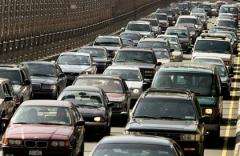Road traffic noise linked to heightened risk of mid-riff bulge

Road traffic noise is linked to a heightened risk of developing a mid-riff bulge, indicates research published online in Occupational & Environmental Medicine.
Exposure to a combination of road traffic, rail, and aircraft noise may pose the greatest risk of acquiring a spare tyre—otherwise known as central obesity, and thought to be one of the most harmful types of fat deposition around the body—the findings suggest.
The researchers assessed how much road traffic, rail, and aircraft noise 5075 people living in five suburban and rural areas around Stockholm, Sweden, had been exposed to since 1999.
They did this, by using official figures on road and rail traffic noise levels and flow. This included information on ground surfaces, building heights, speed limits and noise barriers from the five municipalities. And they used national data on aircraft noise from Stockholm's main airport, Arlanda.
All the participants and had been part of the Stockholm Diabetes Prevention Program (1992-8), which aimed to look at risk factors for the development of diabetes and how best to prevent it.
Between 2002 and 2006, when they were aged between 43 and 66, they completed a detailed questionnaire covering lifestyle, current state of health, levels of psychological distress, insomnia and job strain. They were also asked about environmental noise pollution from road traffic, trains, and planes.
And they underwent a medical, which included blood pressure and a test for diabetes, as well as measures of central body fat (waist and hips and the waist:hip ratio), and overall obesity (weight and height to define the body mass index or BMI).
The researchers calculated that well over half (62%, 3127) had been regularly exposed to road traffic noise of at least 45 decibels (dB) while one in 20 had been exposed to similar levels of noise from trains. A further 1108 had been exposed to aircraft noise of more than 45 dB.
In all, just over half (54%, 2726) had been exposed to one source of traffic noise; 15% (740) to two sources; and 2% (90) to all three. Around a third (30%, 1519) had been exposed to levels below 45 dB, which were not considered to be harmful.
The analysis indicated no link between road traffic noise and BMI. But there was an association between road traffic noise and waist size, with a 0.21 cm increase for every additional 5 dB increase in exposure, although this was only significant among women.
Similarly, there was a link to waist:hip ratio, with a change of 0.16 for every 5 dB increase in noise exposure to road traffic; this association was stronger in men.
A larger waist was significantly associated with exposure to any of the three sources of noise, but the link was strongest for aircraft noise; a larger waist:hip ratio was associated with road traffic and aircraft noise only.
There seemed to be a cumulative effect, however: the more sources of noise pollution a person was exposed to at the same time, the greater their risk of central obesity seemed to be.
The heightened risk of a larger waist rose from 25% among those exposed to only one source to almost double for those exposed to all three sources.
The findings were not influenced by socioeconomic factors, lifestyle, or exposure to ambient air pollution from local road traffic. But age was an influential factor, with associations between central obesity and road traffic noise only found for those below the age of 60.
This is an observational study so no definitive conclusions can be drawn about cause and effect, nor were the researchers able to assess levels of residential sound insulation or the location of the participants' bedrooms.
But noise exposure may be an important physiological stressor and bump up the production of the hormone cortisol, high levels of which are thought to have a role in fat deposition around the middle of the body, they suggest.
"This may explain why the effects of noise were mainly seen for markers of central obesity, such as waist circumference and waist-hip ratio, rather than for generalised obesity, measured by BMI," they write.
Traffic noise from any of the three sources may also affect metabolic as well as cardiovascular functions, through sleep disturbance, they suggest, altering appetite control and energy expenditure.
More information: Exposure to traffic noise and markers of obesity, Occupational & Environmental Medicine, DOI: 10.1136/oemed-2014-102516
















